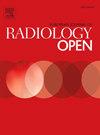在学术放射科实施自动乳腺超声系统:头三年的经验教训
IF 2.9
Q3 RADIOLOGY, NUCLEAR MEDICINE & MEDICAL IMAGING
引用次数: 0
摘要
目的评价ABUS在某学术放射科实施后3年内的诊断效果。方法在本回顾性研究中,纳入了2015年10月至2018年10月期间接受ABUS筛查和诊断的女性,这些女性均有足够的随访和明确的诊断。妇女在同一天接受了ABUS + /-乳房x光检查。1/ 2的BI-RADS患者在随访期间诊断为癌症,且在之前的检查中已经可见,被认为是假阴性(FN)。3/4的BI-RADS呈良性,被认为是假阳性(FP)。比较了三年来FP和额外靶向HHUS (addHHUS)的数量。结果纳入1248例女性(51.2 ± 11.2岁):956例(77.3% %)行ABUS+乳房x光检查;283(29.3 %)仅限ABUS。平均随访时间± SD为53.5 ± 17.8个月。在调查的检查中发现33例恶性肿瘤。28/ 33例(84.8 %)病变被划分为BI-RADS 4或5级,1例(3.6 %)病变仅在ABUS中可见。3/33例恶性肿瘤(9 %)BI-RADS为3级。2/33(6 %)在乳腺x线摄影和ABUS中可见,但未被识别和分类为BI-RADS 2 (FN率6.1 %)。回顾性分析,两例患者冠状像均有“缩进现象征”。无恶性BI-RADS 3和BI-RADS 4分别为172例(13.8 %)和14例(1.1 %),FP率分别为15.3 %。三年中,FP的数量以及addhsus的数量显著减少(p均为 <; 0.001)。结论实施ABUS后,FP病例和addhus随时间的推移而减少。本文章由计算机程序翻译,如有差异,请以英文原文为准。
Implementation of an automated breast ultrasound system in an academic radiology department: Lesson learned in the first three years
Purpose
To evaluate the diagnostic performance of an ABUS in an academic radiology department over the first three years after its implementation.
Methods
In this retrospective study women undergoing ABUS examination for screening and diagnostic purposes between October 2015–2018 were included in case of sufficient follow-up and established diagnosis. Women underwent ABUS + /- mammography in the same day. BI-RADS 1/ 2 cases with cancer diagnosis during follow-up and already visible in the previous exam were considered false negative (FN). BI-RADS 3/4 cases proved benign were considered false positive (FP). FP and number of additional targeted HHUS (addHHUS) were compared over the three years.
Results
1248 women (51.2 ± 11.2 years) were included: 956 (77.3 %) underwent ABUS+mammography; 283 (29.3 %) ABUS only. Mean follow-up ± SD was 53.5 ± 17.8 month. Thirty-three malignancies were present in the investigated exams. In 28/ 33 cases (84.8 %), lesions were classified BI-RADS 4 or 5 and one (3.6 %) lesion was only visible in ABUS. 3/33 malignancies (9 %) were classified BI-RADS 3. 2/33 (6 %) were visible in mammography and ABUS but not recognized and classified BI-RADS 2 (FN rate 6.1 %). Retrospectively, both cases had “retraction phenomenon sign” in the coronal images. BI-RADS 3 and BI-RADS 4 without a malignancy were attributed to 172 (13.8 %) and 14 (1.1 %) cases, respectively corresponding to a FP rate of 15.3 %. The number of FP as well as the number of addHHUS significantly reduced over the three years (both p < 0.001).
Conclusions
After the implementation of an ABUS FP cases and addHHUS reduce over the time.
求助全文
通过发布文献求助,成功后即可免费获取论文全文。
去求助
来源期刊

European Journal of Radiology Open
Medicine-Radiology, Nuclear Medicine and Imaging
CiteScore
4.10
自引率
5.00%
发文量
55
审稿时长
51 days
 求助内容:
求助内容: 应助结果提醒方式:
应助结果提醒方式:


